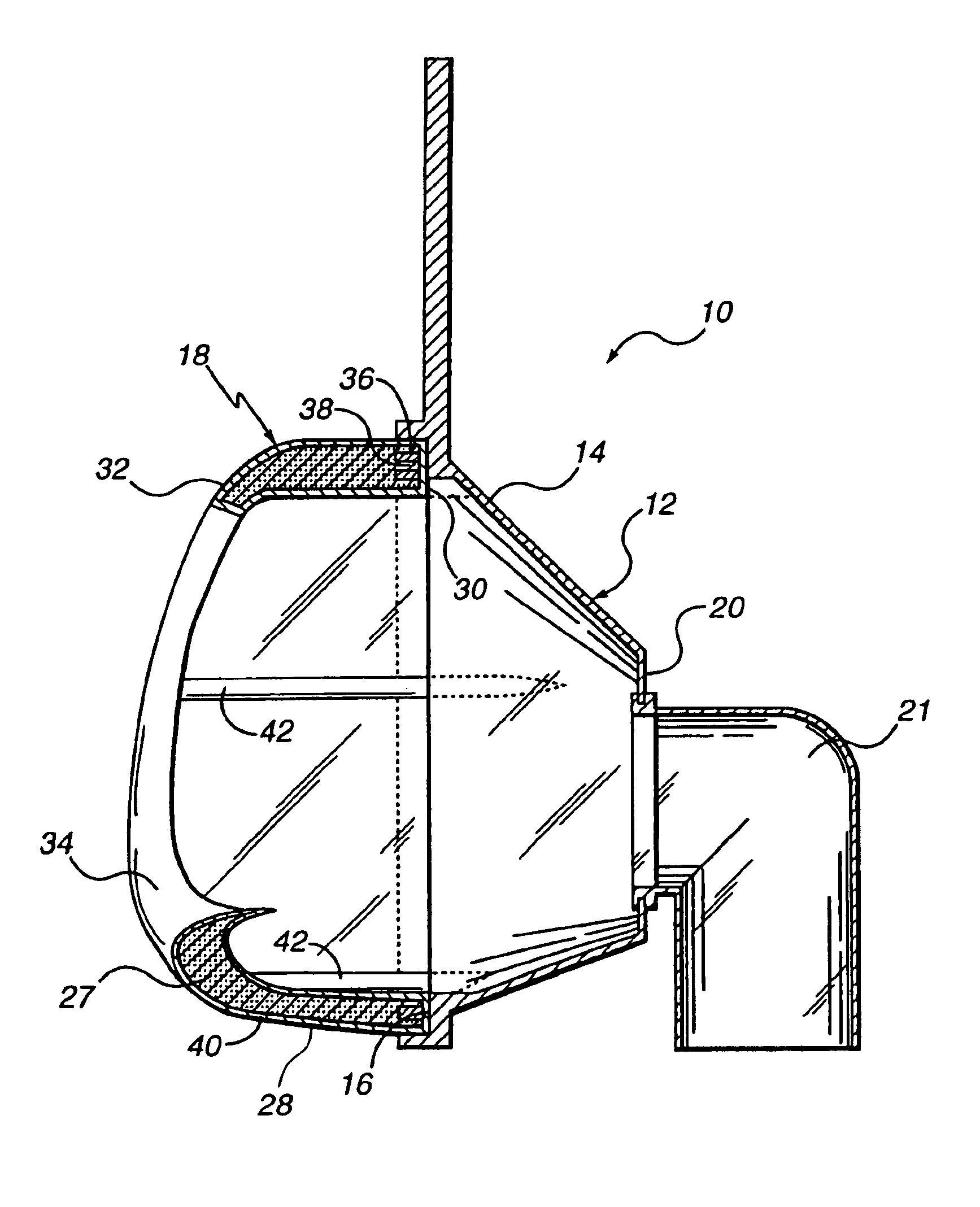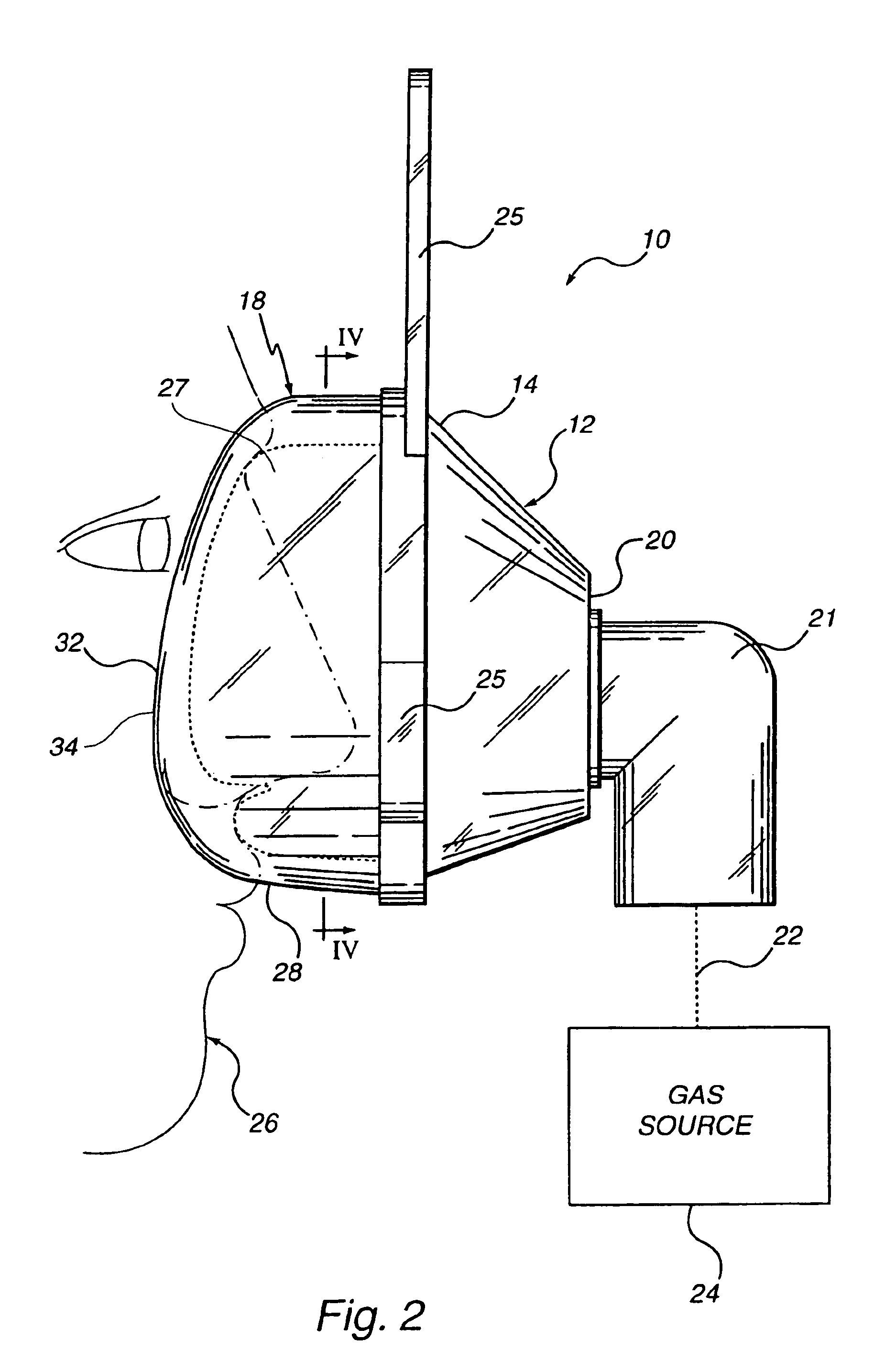Commonly, in conventional
mask configurations, a good mask-to-
face seal has been attained in many instances only with considerable discomfort for the user.
This problem is most crucial in those applications, especially medical applications, which require the user to wear the mask continuously for hours or perhaps even days.
In such situations, the user will not tolerate the mask for long durations and optimum therapeutic or diagnostic objectives will not be achieved, or will be achieved with great difficulty and considerable user discomfort.
However, if the seal fit is not good, there will be gaps in the seal-to-face interface resulting in gas leaking from the mask at the gaps.
Such excessive force is unacceptable because it produces
high pressure points elsewhere on the face of the user where the mask seal contour is forcibly deformed against the face to conform to the user's facial contours.
This will produce considerable user discomfort and possible
skin irritation and breakdown anywhere the applied force exceeds the local
perfusion pressure, which is the pressure that is sufficient to
cut off surface
blood flow.
The problem of seal
contact force exceeding desirable limits is even more pronounced when the
positive pressure of the gas being supplied is relatively high or is cyclical to relatively high levels.
This produces high localized pressure on the face, not only in the zone of the mask seal, but at various locations along the extent of the retention straps as well.
This, too, will result in discomfort for the user after only a brief time.
Even in the absence of excessive localized pressure points, the tight mask and headstraps may become extremely uncomfortable, and user discomfort may well cause discontinued cooperation with the
treatment regimen.
The inherent stiffness of the
central layer in combination with the
structural rigidity provided by the V-shaped channels, especially when overfilled with gel / air, results in a comparatively unyielding facial seal.
As will be appreciated, the comfort afforded such a construction is quite limited and certainly not appropriate for those applications, such as respiratory therapy situations, where a user must occasionally wear a mask for prolonged periods of time.
That is, the foam materials and the air entrapped within them tend to be poor conductors of heat.
Bacteria, in turn, contaminates the foam thereby considerably hindering its useful service life.
Hence, apart from generally failing to provide optimum sealing with respect to a user's face, the inherent qualities of foam mask seals have been linked to
skin irritation and breakdown, particularly at some of the more prominent facial contours, such as the
cheek bones and bridge of the
nose.
Moreover, whether air, fluid or, in the case of U.S. Pat. No. 5,181,506, gel filled, or whether formed as an
elastomer such as foam, plastic, rubber,
silicone and the like, the resiliency or
recoil characteristics of presently available
cushion type
respiratory mask seals have not been well suited to form an effective seal with the
topography of the user's face in the absence of considerable headstrap tensile forces.
This technique, however, is
time consuming and costly, and, therefore, is not well suited for conventional, large-scale manufacturing processes.
The present inventor also discovered that, contrary to expected results, a satisfactory seal may not result from a micro-customized mask.
It is believed that a relatively detailed micro-customized mask, closely matching the detailed contours of the
soft tissue at the surface of a patient, does not provide a satisfactory seal because changes in seal position and / or changes in the
soft tissue of the patient may result in new gaps being created between the seal and the patient.
For this reason, a mask that has a micro-customized seal made from the above-described
casting process, because it is specifically designed to match the contours in the
soft tissue of the patient's face at the time the cast was made, typically does not have the ability, or has only a limited ability, to change its shape in the event of changes in the patient's shape or shifts in the mask position.
This
disadvantage is especially pronounced if the mask having such a micro-customized seal is used in situations where the patient is likely to move and / or in situations where the mask is likely to be jostled, such as during sleep.
However, because this
macro-customized, i.e.,
off the shelf, mask is not specifically customized to match the facial features of a specific user, it often does not permit a sufficient degree of customization to account for facial contours specific to each patient.
For example, for patients with unusual facial features,
off the shelf macro-customized masks typically do not provide a satisfactory seal and can result in pressure points being created as the patient attempts to close these gaps with increased
strapping force.
This
macro-customization process, however, suffers from the same disadvantages discussed above with respect to the micro-customization process.
Namely, it is
time consuming, uneconomical and inefficient to attempt to
mass produce such specifically tailored macro-customized masks.
Macro-customization also suffers from a
disadvantage in that leaks resulting from the physical characteristics of the soft tissue of the patient are not minimized.
Instead, the user will typically attempt to minimize such leaks by increasing the
strapping force, thereby creating the problems of high localized pressure on the surface of the patient.
 Login to View More
Login to View More  Login to View More
Login to View More 


